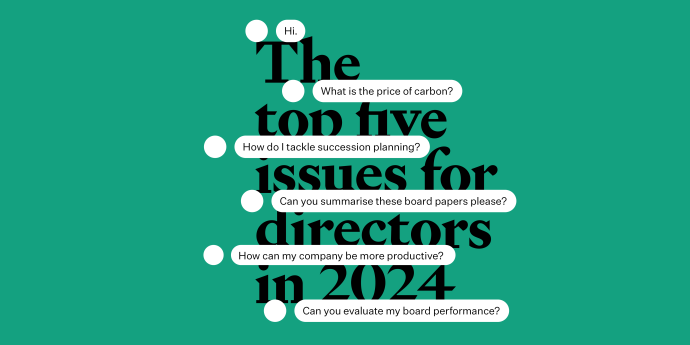The Economic Power of Gender Equality
Reasearch shows that diversity and equal roles for women delivers better results for people, for the planet and for profits.
In a world in continual crisis, directors need to take their game to a whole new level.

The world is more volatile and uncertain than most leaders have ever known. Four out of five business leaders anticipate this volatility will persist for at least the next two years, according to the World Economic Forum’s 2023 ‘Global Risks Perception Survey’. And boards are getting a sense of almost permanent crisis.
Business as usual, whatever that meant, has gone. The “permacrisis”, as consulting firm Oliver Wyman describes it, is here. As a result, directors need to excel as navigators in the face of increasing geopolitical and regulatory ambiguity, particularly with the arrival of a new government.
There is a need for directors to set the right tone, to make sure their organisations are exceptionally adaptable and ready to handle the next crisis.
Our ‘Top 5 Issues for Directors in 2024’ reflects the major risks that New Zealand boards are going to face:
New Zealand’s international commitments on reducing greenhouse gas emissions remain and there is renewed focus on action to make progress towards delivering these goals.
In 2024, carbon pricing through the New Zealand Emissions Trading Scheme seems likely to take on new importance. This could see carbon pricing playing a pivotal role in incentivising organisations to reduce their emissions, along with measures to provide greater market certainty.
The focus is quickly moving beyond merely understanding your emissions profile and “knowing your number”, including information about suppliers and customers. Boards need to think both short and long term, and to strategise wisely by factoring in the organisation’s response to anticipated rises in carbon prices in years to come. Investment in emissions abatement needs to be considered because inaction risks higher future operational costs and a potential drop in competitiveness and productivity.
The importance of climate leadership by boards has never been more pressing. The world faces massive challenges in meeting the Paris Agreement goals, necessitating heightened urgency and action.
With escalating weather events, and regions still recovering from disasters such as the Auckland Anniversary Weekend floods and Cyclone Gabrielle, which have led to a combined national estimated cost of $3.5 billion in insurance claims, boards must continue to be resolute in preparedness.
In addition, climate change will impact beyond physical infrastructure or through supply chain disruptions. With the potential for more severe and more sustained droughts, impacts on the availability of water and its quality will become more evident. There will also be impacts on rural and urban land use, including through managed retreat.
All of this will affect bird and other animal life, trees, bush and forests. These wider impacts on nature will be increasingly important for boards to consider over the coming year and into the future.
Directors should ensure the agenda includes:

AUTHOR: Phil Veal MInstD
There is a lot going on in the world that we as directors need to get our heads around. Cyber security, AI, peak globalisation, Ukraine and Palestine. Even amid all that noise, climate and its potential effects on a changing world remain top of the list of concerns around the board table in 2024. So why is climate important in governance?
Climate represents a once-in-several- generations opportunity to invest in New Zealand’s future, one that is driven by two strong forces. Firstly, consumer preferences are swinging strongly to sustainability (notwithstanding concerns around the cost of living). Secondly, we have made commitments (Net Zero 2050) that are creating significant changes in regulation for business.
For far too long, New Zealand has underinvested in our future. That includes a lack of investment in infrastructure, in developing our people, in technology, automation and productivity. But what boards need to understand is that we now have a chance to seize an opportunity in climate investment, which will allow us to address our earlier skimping, and tackle big changes in a way that will make a difference.
Investing in our future is just better business. As we move to net zero, lower carbon emissions will create more efficient businesses, which means better returns for investors and a more resilient economy. A healthier natural world means thriving, healthy communities, resulting in a better quality of life for all
In 2023, Cyclone Gabrielle reminded us we have lived in a predictable world for long enough to know we can’t be ‘unprepared’ for unpredictability. Extreme weather events have shown us what happens if businesses aren’t prepared, or lack resilience. And as insurance costs continue to rise, it will soon force changes in where we build, or where we relocate. We also need to be prepared for non-linear change – ‘black swan events’ – in our environment.
In today’s economy, carbon is a resource. That means we all need to know the price of it, and how to represent it in our operating models and financial statements. Know your number. Report it. Let’s hold ourselves to account as we invest to reduce our numbers.
As we contemplate the effect that a new government will have on our organisations, we should remember this: the short-term incentives may change, but our collective long-term incentives (Net Zero 2050) are baked in. We need to be careful to keep our eye on the long game.
Business leader Professor David Teece said recently “it’s time for boards to hit the panic button because the world is in a geopolitical crisis where everything’s changing – markets, technology and regulations”.
Maybe he’s right. In any case, think of it as an opportunity to ‘put our foot on the accelerator’. Constructive panic is the most productive force in human enterprise. Let’s all take that mindset back to the mahi in 2024.
Phil Veal MInstD is a private investor, business leader, director and a member of the Chapter Zero New Zealand Steering Committee.
“Succession” is more than just a mini- series based on media mogul Rupert Murdoch and his family. The series is a metaphor for the challenges facing many boards and chief executives – one that needs attention now.
The significant retirement surge of “baby boomers” is under way at both an executive and board level, placing pressure on the availability of talent. The potential risk of lost skills and knowledge gaps looms large if succession is not handled effectively.
The age of CEOs worldwide has been steadily increasing over the past five years with one in six over 60 years old, according to a recent Bloomberg article. However, a notable change occurred in 2022, signalling a shift towards the recruitment of younger CEOs. This transition holds the promise of introducing a more diverse and youthful cohort of chief executives, equipped with expertise in tackling modern challenges.
There is also a suggestion executive talent might be transitioning into board roles sooner, particularly in the aftermath of the Covid-19 pandemic. Despite the average age of IoD members on NZX 50 company boards holding steady at 61, there are signs that younger executives are developing an interest in governance.
The 2023 IoD Director Sentiment Survey found about two-thirds of directors and boards are paying attention to succession planning for chief executives and senior leadership. Recognising this challenge is one thing; acting on it is another.
This is not just about CEOs and their executive teams. It applies equally to boards. Nominations committees will need to move into “overdrive” to ensure there is a widening pool of potential directors to replace an increasingly aging director workforce.
Directors should ensure the agenda includes:

AUTHOR: Alison Barrass CFInstD
It may sound obvious, but the way in which boards approach succession planning and recruitment can have a dramatic impact on the fortunes of an organisation. Success starts with people. If you don’t have the right people, everything else becomes difficult.
Whether thinking about future board members, or a future chief executive, the process undertaken to find and assess people can have a huge impact on organisational culture, the ability to deliver on strategic goals and purpose, and the very sustainability of a business model.
Boards should accept that succession planning will take considerable thought in today’s fast-changing and uncertain business environment, and directors should not see it as a formality. Doing it right might take more work, but it pays significant dividends to the effectiveness of the board.
I think about succession planning in three areas. The first is to make sure you run an agnostic, professional and robust process. Surprisingly, this is not always the case.
A robust process should encompass an understanding of the broader skill gaps but also factor in the real value of diversity in an ever-changing future.
I don’t think it is good enough, these days, to be shoulder tapping or going into the contacts list and pulling people from there.
My second piece of advice is to ensure succession planning is aligned with organisational strategy.
It is easy, but often a mistake, to recruit the type of board member you recruited last time. Everyone is aware of complexity and the rapid pace of change. If you factor in your strategy, you may find the people you need now are not the same as the people you needed last time.
This perspective needs to be shared with the recruiters who help find suitable candidates. Many recruiters in New Zealand have worked with organisations for decades and can sometimes fall into patterns based on past expectations.
You have to ensure your recruiters understand the organisation in its contemporary format. The organisation today may be nothing like it was 10 or 20 years ago.
The third point is talent is not enough. It’s not enough to recruit talent or technical capability. You have to consider values, style, skills, what kind of board member you want. Do you want a challenger, a culture builder, a visionary? Do you need a technical expert? There are layers you have to interrogate as a board in order to understand what you want from an appointment.
Alison Barrass CFInstD is a professional director.
Artificial intelligence has been around for a long time, but it has now exploded into our consciousness. Every week there is a new development, boards are updating their digital and cyber security policies, and younger staff, particularly, are experimenting and finding labour-saving ways to use this technology.
In 2023, the emergence of widely available generative AI marked a significant milestone, with ground- breaking products such as ChatGPT, Bing AI, Microsoft Copilot and Bard AI, entering our homes and workspaces. This transformative wave continues, promising to redefine industries by enhancing efficiency, cost-effectiveness and driving unprecedented growth. The potential to drive productivity improvements is significant.
New Zealand companies and organisations cannot put their heads in the sand. Directors must recognise the importance of preparing for a future in which AI permeates every facet of the business or organisation, including getting products to market quicker, being more responsive to those who are being served, and the integration of generative AI into core products.
Experts point to “exponential change” with generative AI and that may put boards and the management they support under significant pressure. According to a 2023 KPMG US study, at least 75 per cent of business leaders saw generative AI as one of the top three emerging technologies over the next 12 to 18 months.
The speed of this transformation underscores the urgency for directors to cultivate curiosity and deepen their understanding of the opportunities that lie ahead. This is essential if boards are to add value.
While prudent consideration of potential risks is vital, it is equally important to approach this technological leap with a proactive mindset, focusing not solely on the challenges but also on the abundant possibilities.
Directors need to be aware that imposing policies barring AI usage may not stop staff leveraging its benefits in their work. A balanced, realistic approach is essential, in which setting clear guidelines and expectations are important, but so is encouraging a culture of innovation and experimentation.
Directors should ensure the agenda includes:

AUTHOR: Tom Hovey MInstD
Where will AI be in five years’ time? That’s what we should be asking ourselves. AI never sleeps and never gets tired, and it’s improving all the time. It’s phenomenal how quickly the quality is improving. We really are at the beginning of the journey.
AI tools will speed up everything we do, thereby saving time and reducing effort. The world is already getting faster and faster, and AI is another massive accelerant.
My definition of AI is a computer process that translates inputs (like text prompts) and applies judgment by looking at almost infinite data points and ‘thinking’ about your intent. And then it arrives at a conclusion and generates an output. The output could be text, a chart, an image, a data table, code, anything at all. AI is really good at translation and connecting data points. That’s what makes it really exciting. It can quickly join dots that we humans struggle with because it has vast processing power.
Directors can use AI to save time, become more efficient and make better decisions. An AI-powered bot could be listening to a board and giving it feedback in real time: ‘I haven’t heard from this board member and I think everybody should be contributing. Or: ‘it’s sounding like you’re all diving into management. You need to lift the conversation up and consider the bigger picture’.
It could even help remove some of the biases that influence board decisions. It might sound far-fetched, but the technology can do that today – even provide sentiment analysis based on facial expressions, tone and other movements.
Board papers play an important role in keeping directors informed and stimulating discussion but imagine feeding them into an AI language model and asking, ‘What are the most important things? What should I be looking at? Can you read this paper and tell me the three questions I should be asking at my next board meeting?’ You can privately give ChatGPT financial statements and it can read and interpret them well.
And, if for fun, you ask ChatGPT to give you a 20-question quiz that evaluates your board directorship skills. ‘Okay, Tom, here’s question one’. It has read everything on the internet and created a quiz for me. It could be the Four Pillars that talks to you.
The efficiency from enterprise AI is going to be phenomenal, but the privacy required to pull it off is equally important. You need to lean into it, start playing with it and thinking about it. For businesses, it can reduce costs. It might mean some roles are no longer needed, but new ones will be created.
Organisations need to focus on building trust now. If you think about the issues with some of the information AI is producing, it is likely we won’t be using Google or websites, we will be relying on content from AI. Being a trusted brand with trusted content is going to become more important than ever.
Tom Hovey MInstD is the director of independent digital strategy consultancy Diagram.
New Zealanders are being 'squeezed', and so are companies and other organisations. Directors are going to be challenged to find new and broader revenue and/or funding sources, to support management to develop innovative products and services that meet new or evolving market needs, and to change production and delivery systems that effectively and efficiently meet these needs.
Confidence in economic and company or organisation performance has improved since 2022. There is, however, a strong sense of economic and financial headwinds, and these are only going to intensify as a result of continuing inflation, high interest rates and the inability to find labour with the right skills.
Pushing through this will require significant innovation, widening and diversifying markets, and being able to widen margins. For not-for-profits, this means finding new funding sources and building up a reasonable level of reserves.
The only way to address the economic squeeze is through increased productivity. This is a measure of how efficiently inputs are converted into outputs, and it is a key driver of economic growth and living standards.
This matters whether or not there is a Productivity Commission. A data report by the commission, Productivity by the Numbers 2023, revealed that growth has been sluggish in New Zealand for many years, lagging behind other OECD countries. Digitalisation, automation, artificial intelligence and sustainable technologies all have the transformative potential to enhance efficiencies, increase quality and support eco-friendliness.
In tandem, there is a need to elevate human capital. Workforce reductions were sometimes considered a quick solution to financial challenges and, in the short term, to increase productivity. However lessons have been learnt from previous retrenchment approaches because staff cuts not only disrupt the workforce but can also hinder an organisation’s ability to ramp up.
These times call for empowerment of the workforce through upskilling initiatives and targeted incentives that extend to include external partners and supply chains.
Directors should ensure the agenda includes:

AUTHOR: Murray Sherwin
“There is nothing so useless as doing efficiently that which should not be done at all.” – Peter Drucker
Productivity is what separates modern, high-income communities from the hunter-gatherers of the ancient world or subsistence tribal groups in parts of the world today. It is the capacity to combine high skills with sophisticated technology and ideas, and to trade the resultant products and services with others that marks out high productivity societies.
High productivity supports high incomes and, with that, better choices about how to support individual and community wellbeing.
Productivity is not about working harder or longer. Nor is it about adding more inputs such as labour, raw materials or capital, to create more output. New Zealand has done a lot of that over the years. Productivity growth comes from working smarter, producing more from less. But more than just working smarter, as the quote from Peter Drucker indicates, working on the right things is crucial.
Broadly, what is true for high productivity economies is also true for high productivity firms. Both face the usual challenge of choosing where to commit their limited resources in order to generate the maximum value for the wellbeing of their people.
Innovation is a key ingredient in the productivity secret sauce. Innovation means risk and change. That calls for leaders to cultivate environments that nurture innovation and ease the risks and discomfort.
What does this mean at the firm level and for boards?
A small, remote island nation starts with some disadvantages in the productivity race. New Zealand is unlikely to support some of the high productivity industries that the US, China or Europe can succeed in. Major international firms are less likely to see New Zealand as an ideal place to build a major industry servicing the global market.
But that doesn’t predetermine a constrained productivity future for New Zealand. We will need to be creative, smart and focused to create our own competitive advantages in industries that suit our scale and setting. As always, the skills and creativity of our people are key to success.
Smart choices by government in the delivery of education and health services, infrastructure and regulatory frameworks are critical. So too, a tax system that encourages innovation and investment while funding the sort of society and natural environment that is the envy of the world.
Murray Sherwin CMInstD is a director and consultant.
The role that directors and boards play is undervalued by the community, organisations and even by directors themselves. An ongoing focus on the ‘frontline’ can lead to an underestimation of the value that good governance can add.
The challenges and risks outlined in these top five issues are significant. Organisations need directors and boards that understand what good governance looks like now, more than ever, and the value boards can add to their company or organisation.
Boards possess a unique opportunity to think ahead to the medium and long term, drawing on their collective knowledge – a viewpoint that other parts of the organisation might not have.
They can offer vital support and advice to the management team when issues are on the move and inundating the organisation. This can be particularly valuable when fast-moving challenges require swift attention. Given the uncertainties in the broader environment, management will greatly benefit from this support, shared from a governance perspective.
Despite overcoming the challenges posed by the Covid-19 pandemic, organisations continue to confront a fresh wave of obstacles. AI, energy transition, calls for increased supply chain transparency, shifting workforce requirements, and the ever-growing threat of cyberattacks are all exerting pressure on existing business models.
Boards must prioritise future planning and support management to adapt. Boards are called on to think in agile ways in order to navigate the changing dynamics of their sector, consider new business models or products, or other necessary changes that could benefit their organisations.
In these situations, boards must excel and acknowledge where they can do better as individuals and as a team. With boards facing pressure to be knowledgeable in a broad range of areas – far broader than what governance was traditionally considered to cover – the need for regular board evaluations and consideration of the skills around the table is more critical than ever.
The board needs to consider whether it’s functioning at its best and what further training and/or skills development is needed. A board evaluation, such as the IoD’s suite of services, can help.
Directors should ensure the agenda includes:

AUTHOR: Mark Verbiest CFInstD
The key thing is to self-evaluate. That can be reflecting on a single meeting or a series of meetings over time.
You should ask yourself or others on the board, sometimes the chair, whether you have added value and how you have added value. And where you have not – and what you might do to improve. People generally know whether and what they have contributed.
Most high-performing directors – even when they are very seasoned – will ask the question, particularly when they are new to a board or new to an industry. They want to ensure they are coming to grips with how things operate in that particular entity and its sector.
When directors don’t seek feedback it often raises questions in terms of how self-aware they might be, where they genuinely think they have contributed and how effective they believe they might be. The rest of the board usually knows too, and this is often picked up through annual evaluations.
As chair, it becomes pretty obvious to me (as to others) the extent to which people are prepared, the extent to which they understand the role, the extent to which they are engaged with others – be they other board members or management – and the extent to which they are trusted and respected.
I have found the odd director who is less experienced feeling the need to comment on every topic. That is not necessary, by any means. In fact, if you feel that somebody has already said something or you have nothing to add to a conversation, the best thing you can do is not say anything. Sometimes, people have to be reminded of that.
Effective meetings are short ones. It is obvious and really important that people come prepared. Sometimes, I will have a quiet one-on-one with someone after a meeting, generally for their own benefit. It’s about adding value for them and for the organisation.
I have always been a team player and so I tend to think about how the board, as a team, is adding value to the organisation. Are we bringing our experience and knowledge to further long-term strategic objectives and risk assessment?
Board composition is hugely important. If everybody looks the same, talks the same and brings similar experience then you are going to get a less than three- dimensional view. It is important to bring diversity of thought to any issue, in order to advance the company and its strategy.
The more diverse a board is, the more broadly it thinks about long-term value – beyond value in a narrow, financial sense and much more in a holistic and sustainable sense.
A board member’s contribution should always be constructive (related to strategy, related to risk). Just ticking the box is not the objective.
Mark Verbiest CFInstD is chair of Meridian Energy and Summerset Group Holdings.